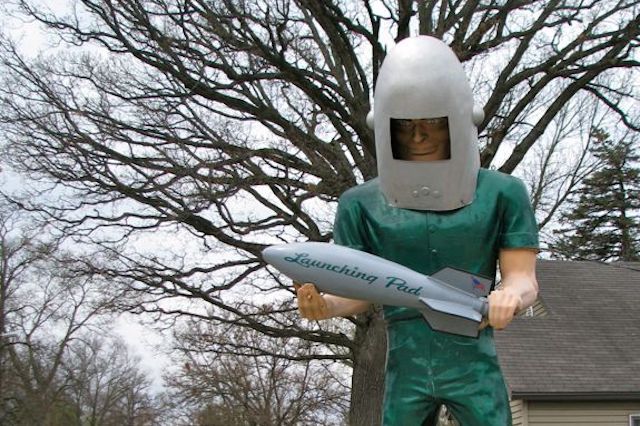You can feel a real sense of satisfaction when you MacGyver up an invention and use one thing in your house to solve a problem in a way that was never intended. There’s a whole industry of “hack” videos that have been around for years showing this off. But not everything is done at an amateur level like this. A lot of well known things were originally designed for totally different reasons that just never really caught on.
10. Silly String Was Designed as a Spray-On Cast

Is any product more fun yet oddly useless as Silly String? The colorful goo strands make any party or festive event more exciting, but the product doesn’t actually do anything. For that reason, it’s maybe not a surprise to learn that it wasn’t developed specifically for pranking friends and making messes. It had a real and arguably important purpose when it was first created.
Originally, an inventor and a chemist worked together on the Silly String formula to create a spray-on cast back in 1972. The idea was to be able to immediately encase a broken bone with a foam-like cast that formed perfectly to the shape of the patient’s limb. And it worked, too. Spray casts are still a thing, even if you don’t see them around all that often. But in the experimentation process, they noticed that one of their nozzles made the substance spray out in a powerful jet, which seemed like fun. So they tweaked the chemical formula to make it less like a cast and more goofy, and Silly String was born.
9. Muffler Men Were all Designed as Paul Bunyan

The term “Muffler Man” may not be well known, but there’s a good chance you know what it refers to. All across America there are giant, fiberglass statues of men that beckon travelers to stop at roadside attractions, diners, tourist traps and, sometimes, muffler shops. They sprung up in the 1960s and remained popular through the 1970s and nearly all of them were designed by the same company, International Fiberglass.
Nearly all of the figures that spread around the country came from the same mold, which was originally Paul Bunyan. The beard could be filled in, or a new chest could be added, but all of these 22-foot tall monsters were the famed lumberjack when they were originally designed.
The company made a Paul Bunyan for a gas station in Las Vegas, and the owner was profiled in a trade magazine where she was quoted as saying her sales doubled as a result. This inspired other businesses to invest in their own giants. Some were cowboys, some were even turned into women. Though rare today, there are still a few dozen scattered across the country.
8. The Rubik’s Cube was Originally Built as a Structural Problem

Erno Rubik invented the Rubik’s Cube back in 1974, but it was never intended to be the puzzle phenomenon that it became. Rubik was a bit of an odd duck and had devoted most of his life to architecture. He was an inventor as well, but architecture and teaching it was his area of expertise. While some stories of the invention of the cube talk about how Rubik was looking for something to teach dealing with three-dimensional objects to his students, and you can even find this explanation on his Wikipedia page, Rubik disagrees.
Rubik himself clarified in an interview that yes, he showed the cube to his students, but no, he didn’t build it to teach them anything at all. He built it for himself as a visual aid to solve a structural problem. He liked geometric shapes and wanted to figure out how he could move the individual blocks around without the whole cube falling apart. It was for his own interest and never meant to be a toy or game at all.
He added colored squares to make it easier to track his progress and then, as he mixed it up, he realized he’d created a puzzle that would be incredibly hard to solve.
7. The Spire of the Empire State Building Was Originally a Zeppelin Docking Station

You may have seen a famous photo of a zeppelin docked at the Empire State Building that circulated around the internet several years ago. The photo is a fake and oftentimes the story that accompanies it mentions that there was a plan for a docking station, but it never materialized because it was deemed impractical.
That said, an extra 200 feet was added to the original height of the building in the form of a mooring mast that was ostensibly a scheme to make the building taller than the Chrysler building. This happened back in 1929. So the idea was a stunt and never meant to be seriously used. Except that it was, but just once.
In 1931, a privately owned blimp floated up to the mooring station and docked for three minutes in 40 mile per hour winds. It was the first and only zeppelin to dock there and confirmed that, despite never seeing use again, that spire on top of the building really is a docking station
6. Mountain Dew was Designed as a Whisky Chaser

Mountain Dew accounts for about seven percent of soda sales in the US per year. All things being equal, that’s fairly significant. When it was first created back in 1932, it was meant to help chase moonshine whisky, rather than just be enjoyed on its own. The brew was invented by brothers who had a fondness for moonshine, which was the drink of choice for the discerning drinker in the Appalachians.
Whisky and moonshine were not necessarily smooth beverages back in the day, especially the kind being brewed by amateurs to get wasted. Chasers were also fairly poorly created at the time as well, so the brothers wanted something to make their drinking experience a little nicer and Mountain Dew was born.
5. Chinese Takeout Boxes were Designed as Oyster Pails

Chinese take out containers are a ubiquitous part of the dining experience in many cities around the world. The little, fold out boxes with a tiny metal handle are convenient and easily recognizable. But they weren’t originally designed to hold your Kung Pow chicken.
Frederick Weeks Wilcox patented the design for the boxes back in 1894. These were just a folded version of the oyster pail, which was just what the name suggested, a pail for oysters. It was cheap, lightweight, and leak-proof, which made it ideal for oysters and, in turn, the burgeoning Chinese food industry that was springing up in America at the time.
4. Jagermeister was a Cough Suppressant and Digestive Aid

Jagermeister is a German liquor that has a very distinctive taste thanks to the 56 different herbs that go into the recipe. It was developed back in 1934 and has proven to be a fairly popular shot. Seven million 9-liter cases of it were sold in 2020, so there are a lot of people out there enjoying it.
If you’ve ever had Jagermeister and felt it was a little medicinal, you’re not wrong. The makers of Jager weren’t trying to revolutionize college parties when they made the drink. It was originally made as a digestive aid and also a cough suppressant.
The original intent was to enjoy a drink after dinner so it would aid you in your digestion and settle your stomach. The drink didn’t really reach widespread use and appreciation until the 1970s and that’s when people started drinking it just for fun as opposed to the original medicinal reasons. Ironically, there’s a good chance Jagermeister has caused far more people to vomit thanks to excess drinking than it ever helped as a medicinal product.
3. Kleenex was Originally Designed as a Gas Mask Filter

Kleenex is so commonplace these days that most people use the term to refer to any tissue, even though it’s a specific brand name. Kimberly-Clark, the company that makes Kleenex, pulled in $19.4 billion in revenue in 2021 and the bulk of their profits come from Kleenex itself along with Huggies and Kotex.
While nowadays everyone uses Kleenex to clean their glasses, wipe spills and blow their noses, the product did come from very different beginnings. It came into being back before 1920 and for years the product, not yet known as Kleenex, was used to filter gas masks during the First World War. The product was made from wood pulp and went by the name Cellucotton. Real cotton was in short supply at the time because the war effort it needed elsewhere, so the Kleenex product was a real life saver, literally and figuratively. After that they tweaked the crepe paper to create Kotex, which is still the brand name used today for the feminine hygiene products.
By 1924, the product was known as Kleenex and was being sold as a cold cream and make up remover. It wasn’t until 1929 that the company had the idea to propose Kleenex as a replacement for a handkerchief which, if you’re keeping count, would be the fourth use for the product.
2. Chainsaws Were Originally Designed for Surgery

The idea of mixing flesh with a chainsaw is not a pleasant one and you don’t need to watch any horror movies to come to that conclusion. They’re brutally powerful tools that make short work of trees so obviously they’d do terrible things to living tissue. Despite that, chainsaws buzzed into existence as medical tools once upon a time.
A pair of 18th century Scottish doctors came up with the original chainsaw. One of the original uses was to cut out diseased bone and sure, that seems plausible if painful. The other intended purpose was symphysiotomy. That’s a widening of the pelvic area to assist in childbirth.
When Cesarean sections were not an option, parts of the pelvis were cut apart and these early chainsaws were used. They were hand cranked and were much smaller than the kind of tools a lumberjack might use, but the idea was much the same. Cartilage in the pelvic area was cut out with a small, knife-sized rotating saw which increased the space by several centimeters to allow for easier childbirth.
1. Thin Fridge Magnets Were Designed for Particle Accelerators

If you don’t have a magnet on your fridge right now, chances are you used to at some point or at least know someone who does. In particular, one of those ultra thin flat magnets that are often used as promo items for businesses. Lots of pizza places use them to make it easy for you to keep a phone number handy. They’re cheap to produce and unique insofar as while one side is magnetic, the other side isn’t. This is in direct defiance of everything we know about magnets which states they have opposing poles. And while they make great ads, they were originally designed to be used in particle accelerators.
These magnets are what’s called a Halbach array. They were designed in the 1980s by physicist Klaus Halbach as a way to focus lasers, electrons, and particle beams. They have a strong field on only one side while the opposite side is negligible. For that reason you’ll also see this kind of magnet used in places like maglev trains which allow the train to essentially float on that single-sided magnetic field created by the Halbach array.